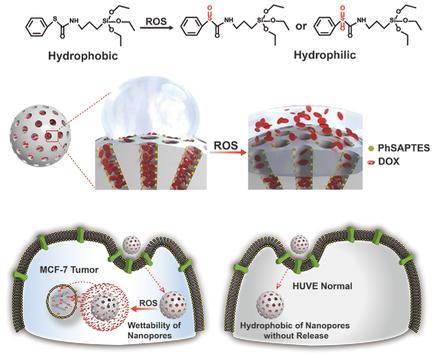Our official English website, www.x-mol.net, welcomes your
feedback! (Note: you will need to create a separate account there.)
Free‐Blockage Mesoporous Anticancer Nanoparticles Based on ROS‐Responsive Wetting Behavior of Nanopores
Small ( IF 13.0 ) Pub Date : 2017-08-25 , DOI: 10.1002/smll.201701942 Yaya Cheng 1 , Xiangyu Jiao 1 , Tailin Xu 1 , Wenqian Wang 1 , Yu Cao 1 , Yongqiang Wen 1 , Xueji Zhang 1
Small ( IF 13.0 ) Pub Date : 2017-08-25 , DOI: 10.1002/smll.201701942 Yaya Cheng 1 , Xiangyu Jiao 1 , Tailin Xu 1 , Wenqian Wang 1 , Yu Cao 1 , Yongqiang Wen 1 , Xueji Zhang 1
Affiliation

|
To achieve an excellent delivery effect of drug, stimuli‐responsive nano “gate” with physical blockage units is usually constructed on the surface of the mesoporous silica nanocarriers (MSNs). In nature, the aquaporins in cell membrane can control the transport of water molecules by regulating the channel wettability, which is resulted from the conformational change of amino acids in the channel. Inspired by this phonomenon, herein a new concept of free‐blockage controlled release system is proposed, which is achieved by controlling the wettability of the internal surface of nanopores on MSNs. Such a new system is different from the physical‐blockage controlled release system, which bypasses the use of nano “gate” and overcomes the limitations of traditional physical blockage system. Moreover, further studies have shown that the system can selectively release the entrapped doxorubicin in human breast adenocarcinoma (MCF‐7) cells triggered by intracellular reactive oxygen species (ROS) but not in normalhuman umbilical vein endothelial cells (HUVECs) containing ROS with low levels. The wettability‐determined free‐blockage controlled release system is simple and effective, and it can also be triggered by intracellular biological stimuli, which provides a new approach for the future practical application of drug delivery and cancer therapy.
中文翻译:

基于纳米孔的ROS响应润湿行为的自由封闭介孔抗癌纳米粒子。
为了获得出色的药物递送效果,通常在中孔二氧化硅纳米载体(MSNs)的表面上构建具有物理阻断单元的刺激响应纳米“门”。实际上,细胞膜中的水通道蛋白可通过调节通道的可湿性来控制水分子的运输,这是由通道中氨基酸的构象变化引起的。受此声波现象的启发,本文提出了一种新的自由阻滞控释系统的概念,该概念是通过控制纳米孔在MSNs上的内表面的可湿性来实现的。这种新系统不同于物理阻滞控制释放系统,后者绕过了纳米“门”的使用,并克服了传统物理阻滞系统的局限性。而且,进一步的研究表明,该系统可以在细胞内活性氧(ROS)触发的人乳腺腺癌(MCF-7)细胞中选择性释放被困的阿霉素,但在含有低水平ROS的正常人脐静脉内皮细胞(HUVEC)中则不能释放阿霉素。由润湿性确定的自由阻滞控释系统既简单又有效,它还可以通过细胞内生物刺激来触发,这为药物输送和癌症治疗的未来实际应用提供了一种新方法。
更新日期:2017-08-25
中文翻译:

基于纳米孔的ROS响应润湿行为的自由封闭介孔抗癌纳米粒子。
为了获得出色的药物递送效果,通常在中孔二氧化硅纳米载体(MSNs)的表面上构建具有物理阻断单元的刺激响应纳米“门”。实际上,细胞膜中的水通道蛋白可通过调节通道的可湿性来控制水分子的运输,这是由通道中氨基酸的构象变化引起的。受此声波现象的启发,本文提出了一种新的自由阻滞控释系统的概念,该概念是通过控制纳米孔在MSNs上的内表面的可湿性来实现的。这种新系统不同于物理阻滞控制释放系统,后者绕过了纳米“门”的使用,并克服了传统物理阻滞系统的局限性。而且,进一步的研究表明,该系统可以在细胞内活性氧(ROS)触发的人乳腺腺癌(MCF-7)细胞中选择性释放被困的阿霉素,但在含有低水平ROS的正常人脐静脉内皮细胞(HUVEC)中则不能释放阿霉素。由润湿性确定的自由阻滞控释系统既简单又有效,它还可以通过细胞内生物刺激来触发,这为药物输送和癌症治疗的未来实际应用提供了一种新方法。











































 京公网安备 11010802027423号
京公网安备 11010802027423号